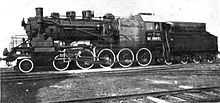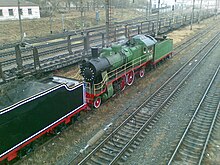SŽD series С у
| SŽD series С у | |
|---|---|
|
С у 252-20
|
|
| Numbering: | different numbering |
| Number: | 1924-1941: 2,270 1947-1951: 411 |
| Manufacturer: | Lokomotivfabrik Bryansk , Kolomna Locomotive Works , Sormovo , luhanskteplovoz , Lokomotivfabrik Kharkov |
| Year of construction (s): | 1924-1941 1947-1951 |
| Retirement: | until 1970 |
| Axis formula : | 1'C1 'h2 |
| Gauge : | 1,524 mm |
| Length: | 13,424mm - 13,594mm |
| Empty mass: | 75.9 t - 81 t |
| Service mass: | 83.3 t - 88.8 t |
| Friction mass: | 54 t - 58.7 t |
| Wheel set mass : | 18 t - 19.7 t |
| Top speed: | 115 km / h |
| Indexed performance : | 1,380-1,565 hp |
| Driving wheel diameter: | 1,850 mm |
| Impeller diameter front: | 1,050 mm |
| Rear wheel diameter: | 1,320 mm |
| Control type : | Walschaert |
| Number of cylinders: | 2 |
| Cylinder diameter: | 575 mm |
| Piston stroke: | 700 mm |
| Boiler overpressure: | 13 bar |
| Number of heating pipes: | 32-40 |
| Number of smoke tubes: | 98-135 |
| Grate area: | 4.73 m² |
| Superheater area : | 71.48-89.35 m² |
| Evaporation heating surface: | 187.76-199.25 m² |
| Service weight of the tender: | empty: 23.5–24 t |
| Water supply: | 23-28.6 m³ |
| Fuel supply: | 17-20 t |
| Particularities: | 36 vehicles with higher axle load (С уT ) 210 vehicles with induced draft fan (С уM ) 2 vehicles with stoker (С уP ) |
The SŽD class С у (German transcription S u ) was a steam locomotive of the Soviet Railways (SŽD) in Russian broad gauge with a 1'C1 'wheel arrangement, delivered over the period from 1924 to 1951 in 2683 copies. It was built on the basis of the Russian С series and was the first steam locomotive that was designed in the USSR . As the most built and proven passenger steam locomotive of the SŽD before the Second World War , it was preferably used in light express train service nationwide on non-electrified routes.
Despite its similar name, it had many design differences from the prototype, so it was called a new design. In contrast to the prototype, it was suitable for driving heavy passenger trains at moderate speeds. It was one of the heaviest passenger steam steam locomotives in the USSR and operated on the vast majority of the country's routes until the late 1960s. In terms of performance, it was considered to be one of the most successful steam locomotives of the SŽD. It was nicknamed Suschka after its chief designer KN Suschkin or Soviet prairie .
prehistory
Towards the end of the First World War , the Russian steam locomotive industry had completely converted its production to freight locomotives. As a result, the freight train locomotive fleet was almost completely renewed (especially due to the production of the Э series ), while passenger locomotives were outdated. This locomotive fleet consisted mainly of locomotives of the С series and was optimized for working with light express trains.
After the October Revolution , an increase in transport services was to be expected. These should be achieved by increasing the pulling weight. This fact led to a need for more powerful locomotives. In 1924 the government received an order from the locomotive industry to produce steam passenger locomotives. Since the construction of the planned M series in the Leningrad locomotive workshop was not yet completed, production of the С у series was initiated at short notice . In terms of shape, the existing class C B locomotive was chosen as a model. Significant changes were made to the project, which resulted in the SŽD's strongest passenger locomotive design.
technical description
The locomotive is a further development of the C B series . Compared to this, the grate area of the fire box has been increased from 3.8 m² to 4.73 m² and the length of the smoke chamber by 0.5 m and the number of heating pipes increased from 24 to 32 while the number of smoke pipes has been reduced from 170 to 135 Piece. The Schmidt- type superheater was replaced by one of the Tschusow type , thereby increasing the superheater area from 51.5 m² to 72.6 m², while the evaporation area decreased from 207.2 m² to 199 m². This brought about an increase in performance. The axis of the boiler was raised from 2900 mm to 3200 mm above the upper edge of the rail , the boiler pressure rose from 12 bar to 13 bar. The chassis was redesigned to use broad gauge wheels. The wheels were designed as spoked wheels throughout .
business
Although the locomotives were originally used as courier locomotives, they were universally applicable. It could travel in light express train service at higher speeds as well as in heavy passenger train service at lower speeds. Their greatest advantage was their low axle load, which made them usable on routes with a light superstructure. They often drove on the rosters of the M and ИС ranks and carried out intermediate duties with lower loads.
At the time of the greatest lack of locomotives between 1947 and 1951, another 411 were built. Their designation is somewhat unclear; In addition to the series designation С у , a three-digit serial number appears, followed by a two-digit number with a hyphen.
The retirement did not take place until the 1960s after the use of diesel and electric locomotives.
Many locomotives have been preserved, such as the С у 251-86, which is based in the Ukraine as a drivable specimen . In addition to this machine, three other locomotives have been preserved as running machines, also four in museums, and 14 vehicles are exhibited nationwide as monuments.
Preserved steam locomotives
Operational
Since the locomotives were built in large numbers and are relatively new, some have been preserved in working order:
- С у 206-56 in St. Petersburg ,
- С у 250-64 in Rostov-on-Don ,
- Су 250-74 in St. Petersburg,
- С у 251-58 in St. Petersburg,
- С у 251-86 at the Zwitkowe station of Odeska Zaliznytsia .
- Су 252-20 in Rostov-on-Don.
In museums
- С у 250-94 in the Tashkent Railway Museum ,
- С у 250-30 in the Brest Railway Museum ,
- С у 214-10 in the Railway Museum in Moscow ,
- С у 252-94 in the Haapsalu Railway Museum ( Estonia ).
- С у 253-15 in the Russian Railway Museum in St. Petersburg.
As monuments
- С у 205-91 at the Ulan-Ude station of the East Siberian Railway ,
- С у 211-85 in the Samara locomotive depot ,
- С у 212-30 (the front part) in the Khabarovsk locomotive depot ,
- С у 213-89 in Penza near the train station,
- С у 214-33 in Kaluga ,
- С у 215-68 in Chilok ,
- С у 216-32 in Smila ,
- С у 251-27 in Schmerynka ,
- С у 251-32 in Nizhny Novgorod ,
- С у 251-98 in Valga ,
- С у 252-20 in Bataisk , not far from the train station,
- С у 252-17 in Homel (locomotive depot),
- С у 253-25 in Kovel near the train station and
- С у 253-33 in Nizhny Novgorod.
See also
Web links
- Film sequence of С у 251-86 on www.gleis4.de
- Photo of the С у 215-15 on Bahnbilder.de
- Photo of the С у 205-91 in Ulan-Ude on Bahnbilder.de
- Passenger steam locomotive С у 253-15 in the Russian Railway Museum in St. Petersburg on Bahnbilder.de




